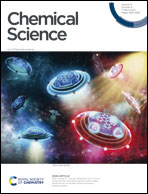Phenazines as model low-midpoint potential electron shuttles for photosynthetic bioelectrochemical systems†
Abstract
Bioelectrochemical approaches for energy conversion rely on efficient wiring of natural electron transport chains to electrodes. However, state-of-the-art exogenous electron mediators give rise to significant energy losses and, in the case of living systems, long-term cytotoxicity. Here, we explored new selection criteria for exogenous electron mediation by examining phenazines as novel low-midpoint potential molecules for wiring the photosynthetic electron transport chain of the cyanobacterium Synechocystis sp. PCC 6803 to electrodes. We identified pyocyanin (PYO) as an effective cell-permeable phenazine that can harvest electrons from highly reducing points of photosynthesis. PYO-mediated photocurrents were observed to be 4-fold higher than mediator-free systems with an energetic gain of 200 mV compared to the common high-midpoint potential mediator 2,6-dichloro-1,4-benzoquinone (DCBQ). The low-midpoint potential of PYO led to O2 reduction side-reactions, which competed significantly against photocurrent generation; the tuning of mediator concentration was important for outcompeting the side-reactions whilst avoiding acute cytotoxicity. DCBQ-mediated photocurrents were generally much higher but also decayed rapidly and were non-recoverable with fresh mediator addition. This suggests that the cells can acquire DCBQ-resistance over time. In contrast, PYO gave rise to steadier current enhancement despite the co-generation of undesirable reactive oxygen species, and PYO-exposed cells did not develop acquired resistance. Moreover, we demonstrated that the cyanobacteria can be genetically engineered to produce PYO endogenously to improve long-term prospects. Overall, this study established that energetic gains can be achieved via the use of low-potential phenazines in photosynthetic bioelectrochemical systems, and quantifies the factors and trade-offs that determine efficacious mediation in living bioelectrochemical systems.

- This article is part of the themed collections: Materials & Energy in Chemical Science - most popular articles 2021 and Biohybrid approaches for energy conversion


 Please wait while we load your content...
Please wait while we load your content...